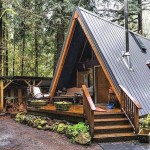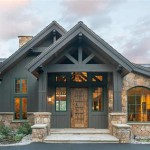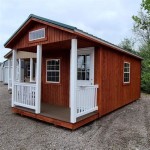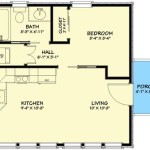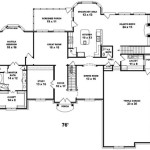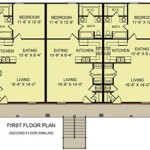Sloping Lot Mountain House Plans: Navigating Elevation for Ideal Mountain Living
Mountainous terrain presents both challenges and opportunities for home construction. A sloping lot, while potentially adding character and views, requires careful consideration during the design and building phases. Sloping lot mountain house plans are specifically tailored to address the unique characteristics of these landscapes, effectively integrating the structure with the natural environment, maximizing views, and minimizing site disturbance. This integration not only enhances the aesthetic appeal but also contributes to the structural integrity and energy efficiency of the dwelling.
The process of designing a mountain house for a sloping lot involves a range of specialized considerations, beginning with a thorough site assessment. This assessment includes analyzing the slope angle, soil composition, drainage patterns, and existing vegetation. The resulting data informs the design process, influencing the foundation type, building orientation, and landscaping strategies. Failure to adequately address these factors can lead to structural instability, water damage, erosion, and other costly problems. Therefore, engaging experienced architects and engineers familiar with hillside construction is crucial for the success of such a project.
Furthermore, local building codes and regulations often impose specific requirements for construction on sloping lots. These regulations may pertain to setbacks, grading, retaining walls, and erosion control measures. Compliance with these regulations is essential for obtaining necessary permits and avoiding legal complications. A well-designed plan will anticipate and address these regulatory requirements from the outset, streamlining the construction process and minimizing delays.
Optimizing Foundation Design for Sloping Terrain
The foundation is the most critical element of any structure, and its design is especially important on sloping lots. Traditional slab-on-grade foundations are often unsuitable for such sites due to the varying depths of soil and the potential for differential settlement. Instead, specialized foundation systems are typically employed, each suited to different site conditions and design requirements.
One common approach is the use of a stepped foundation. This type of foundation follows the natural contours of the slope, creating a series of level platforms upon which the house is built. Stepped foundations are particularly effective for moderately sloping lots and can minimize the amount of excavation required. They also allow for the creation of usable outdoor spaces at different levels, integrating the house with the surrounding landscape.
Another option is a pier and beam foundation, also known as a post and beam foundation. This system consists of vertical piers or posts that extend down to stable soil, supporting a network of beams that form the base of the house. Pier and beam foundations are well-suited for steeper slopes and sites with unstable soil conditions. They allow for airflow beneath the house, reducing the risk of moisture problems and providing access for maintenance and repairs. The space created beneath the house can also be utilized for storage or as a crawl space.
A third approach involves the use of a retaining wall foundation. This type of foundation incorporates a retaining wall at the uphill side of the house, providing lateral support and preventing soil erosion. Retaining wall foundations are often used in conjunction with other foundation systems, such as stepped foundations, to create a stable and level building platform. The design and construction of retaining walls require careful engineering to ensure their structural integrity and ability to withstand the pressure of the soil.
Regardless of the foundation type chosen, proper drainage is essential. Sloping lots are often prone to water runoff, which can erode the soil and damage the foundation. A well-designed drainage system will collect and redirect water away from the house, preventing water damage and maintaining the stability of the foundation. This system may include surface drains, subsurface drains, and strategically placed landscaping to control water flow.
Maximizing Views and Natural Light
One of the primary advantages of building on a sloping lot in a mountain environment is the potential for breathtaking views. Sloping lot mountain house plans are designed to maximize these views, incorporating large windows, decks, and balconies that capture the surrounding scenery. The orientation of the house on the lot is also crucial, ensuring that the primary living spaces are positioned to take advantage of the best views.
In addition to views, natural light is another important consideration. Proper orientation and window placement can maximize the amount of natural light that enters the house, reducing the need for artificial lighting and creating a brighter and more inviting interior. South-facing windows are particularly effective for capturing sunlight during the winter months, while strategically placed overhangs and awnings can provide shade during the summer, preventing overheating.
The design of the roof also plays a role in maximizing natural light and views. Skylights and clerestory windows can bring natural light into the interior of the house, even in areas that do not have direct access to exterior walls. A steeply pitched roof can also create a sense of openness and spaciousness, while allowing for larger windows and better views.
Furthermore, the landscaping around the house can be designed to enhance views and natural light. Trees and shrubs can be strategically placed to frame views and provide shade, while open areas can be left clear to allow for unobstructed sunlight. Native plants are often a good choice for landscaping on sloping lots, as they are adapted to the local climate and soil conditions and require less maintenance. They also blend seamlessly with the natural environment, creating a harmonious and aesthetically pleasing landscape.
Addressing Accessibility and Site Disturbance
Accessibility can be a significant challenge on sloping lots, particularly for individuals with mobility limitations. Sloping lot mountain house plans must address accessibility considerations, incorporating features such as ramps, elevators, and level entryways. These features can make the house more accessible to people of all ages and abilities, allowing them to enjoy the benefits of mountain living without the limitations imposed by the terrain.
The design of the driveway and walkways is also important for accessibility. Steep driveways can be difficult to navigate, especially in winter conditions. A gently sloping driveway with adequate traction is essential for safe and easy access to the house. Walkways should be wide and level, with non-slip surfaces to prevent falls. Handrails may be necessary in certain areas to provide additional support.
Minimizing site disturbance is another crucial consideration when building on a sloping lot. Excavation and grading can disrupt the natural environment, leading to soil erosion, water pollution, and habitat loss. Sloping lot mountain house plans should minimize the amount of excavation required, preserving as much of the existing vegetation and topography as possible. This may involve using specialized construction techniques, such as retaining walls and terracing, to stabilize the soil and prevent erosion.
Erosion control measures are essential during and after construction. These measures may include installing silt fences, straw wattles, and other barriers to prevent soil runoff. Revegetation of disturbed areas with native plants is also important to stabilize the soil and restore the natural environment. A comprehensive erosion control plan will minimize the environmental impact of construction and ensure the long-term sustainability of the site.
In addition to these considerations, sustainable building practices should be incorporated into the design and construction of sloping lot mountain houses. This may include using recycled materials, energy-efficient appliances, and renewable energy sources. Sustainable building practices can reduce the environmental footprint of the house and lower operating costs, making it a more responsible and cost-effective choice.
In conclusion, designing and building a mountain house on a sloping lot requires careful planning and attention to detail. By addressing the unique challenges and opportunities presented by the terrain, it is possible to create a beautiful, functional, and sustainable home that seamlessly integrates with the natural environment. Engaging experienced professionals and adhering to best practices in design and construction are essential for the success of this type of project.

Plan 68753vr Mid Century Modern Mountain House For Rear Sloped Lot Plans

Mountain Modern Steep Slope Hillside House Sloping Lot Plan

Mountain Home Sloped Hill Plans Waterfall House Architecture Model Village Design

Looking For The Perfect Affordable Cottage With A Large Covered Balcony Plan 1143

Mountain House With Open Floor Plan By Max Fulbright Designs

A Guide To Sloping Lot House Plans

Hillside House Plans For A Rustic 3 Bedroom Mountain Home

Hillside And Sloped Lot House Plans

The Best House Plans For Sloped Lots And Narrow Houseplans Blog Com

Hillside And Sloped Lot House Plans

